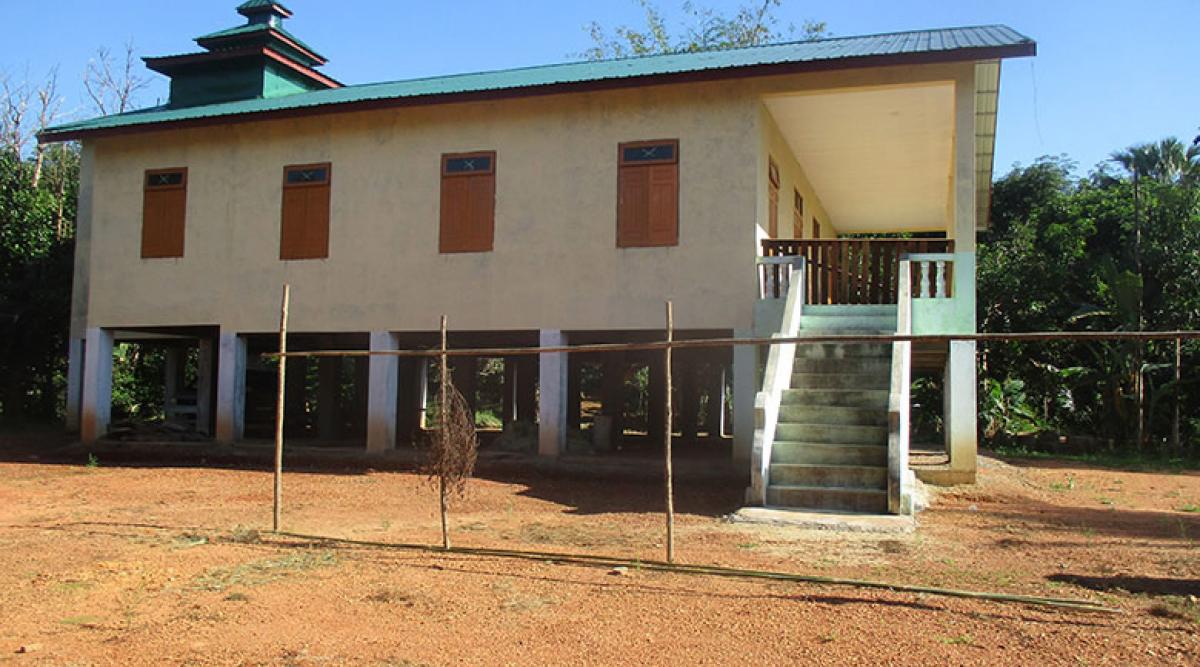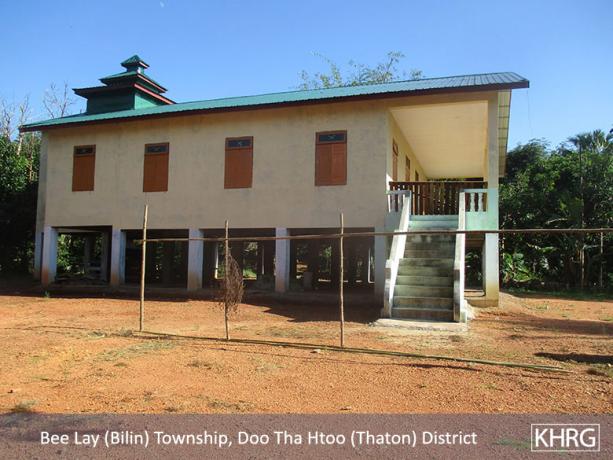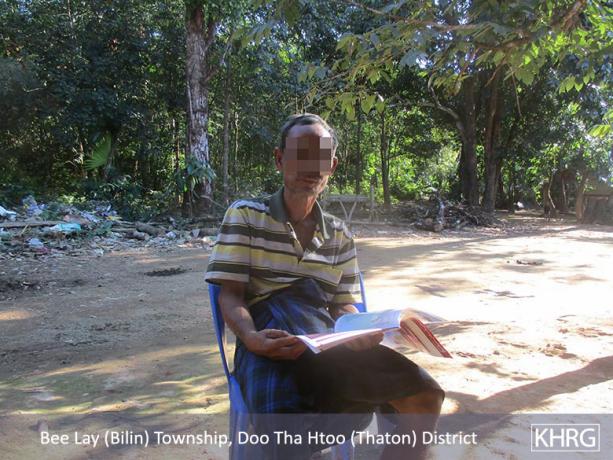This Interview with W-- describes events occurring in Bilin Township, Thaton District, during the period between January and November 2017, and includes information about villagers’ livelihoods, access to education and healthcare, and updates on military activity.
- In 2017, villagers in Htaw Klaw Hkee village, Noh Ber Baw village tract faced challenges in accessing healthcare services due to poor road conditions.
- School transfer letters from local villages were not accepted in Burma/Myanmar government schools. This became a barrier for students in Htaw Klaw Hkee village who wanted to study further by transferring to a larger school, because their local school only went up to Standard Four.
- Tatmadaw Infantry battalion #8 led by Chit Min Thein burnt a Temple in 2016, Htaw Klaw Hkee village and then[Tatmadaw] has already rebuilt it half-way through. However, they went back to their camp since the start of rainy season in 2017; then have not returned yet [as of November 27th 2017].
- Mice damaging paddies and unexpected rain caused livelihoods issues for local people in Noh Ber Baw village tract as they have limited opportunity to earn income.
Interview | W---, (male, 57), Htaw Klaw Hkee village, Bilin Township, Thaton District (November 2017)
The following Interview was conducted by a community member trained by KHRG to monitor local human rights conditions. It was conducted in Thaton District on November 2017 and is presented below translated exactly as it was received, save for minor edits for clarity and security.[1] This interview was received along with other information from Thaton District, including three other interviews and 25 photographs.[2]
Ethnicity: Karen
Religion: Buddhist
Marital Status: Married
Occupation: Farming a hill field
Position: Village elder
What is your name?
My name is W---.
How old are you?
I am 57 years old.
What is your religion?
I am Buddhist.
What is your ethnicity?
I am Karen.
Are you married?
Yes, I am married and I have a family.
How many children do you have?
I have five children.
How old is your oldest child?
My oldest child is 30 years old.
How old is your youngest child?
My youngest child is 18 years old.
What is your occupation or responsibility?
I do not have any special occupation. Currently, I am a local village elder.
How do villagers secure their livelihoods?
Most villagers secure their livelihoods by farming on hill plantations and on their land.
Do villagers produce enough food from their farms?
No, many villagers could not provide enough foods for their livelihoods.
Do they find other ways to provide enough food?
Villagers used to work as casual daily workers to get more income.
What is the biggest challenge for villagers’ livelihoods?
The biggest challenge is mice damaging paddies and unexpected rain. Most villagers’ paddies are almost gone as they were damaged by mice. Some got wet and ruined by unexpected rain in the winter. Some villagers were left with about 20 to 30 baskets of rice but those who planted a small farm did not have any left.
What are the development projects or service providers in this year [2017]?
We do not have any development project in this year [2017] but we had one last year [2016]. For instance, there was a service provider who provided solar panels for households in the village. However, some villagers did not receive any solar panels because the number of panels was insufficient. There are more than a hundred households but only 50 solar panels were provided. Therefore, villagers had to pick up a lucky draw in order to get a solar panel.
How did that service provider solve this problem [inadequate solar panels]?
They went back to fix some damaged solar panels and told us that they will bring more [solar panels] again in 2018.
How did villagers respond to inadequate support?
Even though some villagers were not so happy for not getting solar panel, they understood the situation as the village head told them that this service provider did not know the exact amount of household [in the village] and this support [solar panels] was not requested by villagers as well.
What are challenges in health situation?
The most prevalent disease is flu which mostly affected children. Villagers had to access healthcare services in Ka Ma Moh town quickly whenever they had the flu because the flu was strong.
Don’t you have any healthcare service in this area [Noh Ber Baw village tract, Bilin Township]?
There is a healthcare service in Kwee Lay village but we usually access healthcare service in Baw Thay Leh village as it is closer.
Do villagers pay for medical treatment cost by themselves whenever they are sick?
Of course, we [villagers] have to pay for medical treatment [in the facility in the town]. The biggest challenge is transportation because of poor road conditions. Even though we have vehicles such as car and motorbike, we could not use it for transportation during rainy season. Instead we have to find someone to carry sick people on their back.
Do you have any local healthcare facility in the village?
We have one but they cannot treat serious sicknesses. Therefore, most villagers go to Ka Ma Moh and K’Ter Tee towns or Hpa-an Town to access healthcare services.
Is it easy for local villagers to generate income?
It is so hard to find an income in the local area. The only way for us is to work as casual daily workers.
How do local people generate money or income to pay for their expenses in food or medical treatment?
Some people who have domestic animals such as cows, oxen or buffalos sell them to pay for their general expenses. For those who do not have any domestic animals, lack of finance is a big barrier for them. In this case, some people used to borrow money and then returned it back later.
What are the challenges in education?
There is a challenge in the education system as there is only one local primary school which is up to Standard Four in the village. Students have to use school transfer letters to study further in Burma/Myanmar government school in Baw Kyoh Leh and K’Ter Tee towns. The problem is that Burma/Myanmar government school did not accept local village school transfer letters. Therefore, we [villagers] reported it to local leaders. Eventually, local leaders and township education coordinator suggested that primary students should take school transfer letters from Township [office] and middle school students should take it from District office. Similarly, high school students have to take school transfer letters from the Centre [KNU headquarter]. However, school transfer letters were not accepted by Burma/Myanmar government. Instead, they suggested us to send out our student to Kyauk Thaung Seik [Yo Klah] and Htee Hpa Doh Hta villages. Therefore, we reported it again to local leaders. Then, village school principal and township education coordinator promised that they will try to solve this problem.
How many standards in the school?
The school is up to standard four.
How many students and teachers are in the school?
It is probably more than 150 students and seven teachers in the school. This year, there are fewer because of the school transfer letter barrier. Some students moved to Burma/Myanmar government school before they reached Standard Four [end of primary school], otherwise, they would not be accepted in the Standard they are supposed to study. It is because Burma/Myanmar government teachers ask village school students to study at Standard Four again in authorized school, in order to be able to study further in Burma/Myanmar government school. The principal retired this year as he already worked for 30 years and then he handed over the position to a woman called Naw Htoo. However, we [villagers] still rely on him [previous principal] for any advance suggestions as needed.
Is this school organised by local people [self-funded] or Karen Nation Union (KNU) government?
This is a local people’s self-funded school. But this year, we joined our local village school with a Burma/Myanmar government middle school in Kyauk Thaung Seik village, in order [for our students] to be accepted after graduation. Because of this, we have no other choice even though we do not really want to have a joint school. However, this is the first step for students to be accepted [for further education].
Where do the teachers receive support from?
Teachers received support such as salary and food expenses from Karen Education Department [KED].
How do villagers support teachers?
Villagers support teachers by collecting 2 basket of rice per one student in a year. Then, seven teachers share [the rice] between themselves equally. As a result, a teacher receives about 30 to 40 baskets per year. The villagers who could not provide rice were not forced in this payment. Teachers also received support from Karen Education Department (KED) which is about 180,000 kyat (USD 133.8)[3] but last year they received more than 200,000 kyat (USD 148.6)[4].
Would you like to share any information about the education process?
I do not have any other special cases to share except the school transfer letter issue. We will be very thankful if this goes well. We suggested student to go to Thai border side such as Kwee Lay village because they were accepted there. However, most students continued their study in local area as they have family relatives who stay here. Some students also go to town school in Ka Ma Moh or Hpa-an towns.
Could you share some information about the burnt Temple?
The village temple which was damaged by Tatmadaw has been partially rebuilt [so far, around half of the temple structure has been restored comparing to the previous temple structure].
Is Tatmadaw staying in the village now?
No, they already left one to two months ago [as of November 2017].
Did they leave because they rotate their troop?
I am not sure whether they rotate their troops or not but I know that they did not show up since they went back.
So what do you think about the Temple building?
We do not know what to do because we have never seen a big building that got burnt like this. Tatmadaw group that burnt down the Temple did inform me but I could not do anything except wait for the chief monk’s response. Finally, Tatmadaw restored the damaged temple but they left the village when the raining season came even though the building process was not finished yet.
Which group of Tatmadaw burned this Temple?
It is Tatmadaw Division #44, Infantry Battalion (IB) #8 led by Chit Min Thein. The temple was burnt because a Tatmadaw soldier dropped his cigarette on a petrol spill. Then the fire grew stronger as there were two petrol containers close by.
Did Tatmadaw inform you about the building process such as time to start and finish?
After the temple was burnt, we informed the chief monk in Htee Hpa Doh Hta village. Then, Tatmadaw promised to rebuild it but they asked for the signature of the village head, elders and monk. However, we did not sign this unidentified letter of Tatmadaw as we did not see any official seal on it. Regarding this, Tatmadaw proved that the seal ran out of ink. In the next day, a Tatmadaw Operation Commander came [from center camp] and promised villagers that they would surely rebuild the Temple.
Did they rebuild Temple as they promised?
They did rebuild it even though they rotated their troops. The building process was handed over to a Tatmadaw soldier group that settled in this village. They said that they will rebuild it the best they can. The building process took the whole dry season of 2017 but it is not finished yet. Now, they went back to their base as their building materials were gone and the roads were damaged [because of rain] so it is not easy to transport materials.
Did they ask for villagers’ help in the building process?
They did not ask villagers for help, they used only their soldiers and other engineers. Villagers also could not help them full time as they also have to work in farms for their livelihoods. The only way villagers helped in the building process was by transporting water supply as they need a lot of water for the building process. Some villagers transported water by wood cart, cars or motorbikes on some day according to the order of chief monk. We are not forced to work, we worked in our spare time; because this is not our responsibility to build but the [responsibility of the] Tatmadaw who burnt it. As I observed the building process, I guess it is reliable because it went well. A Tatmadaw operation commander came to the village after the temple was burnt and then he punched Tatmadaw Majors and battalion commanders as a punishment. Then, he [the Operation commander] met with the local monk and promised to reconstruct the temple. Before the Tatmadaw reconstructed this temple, they asked us to choose the structure we liked the most but the chief monk told them to rebuild it according to the previous image of temple.
Will Tatmadaw pay back for other damaged materials in the temple?
We are not sure whether they will provide this material or not but we did give them a list of damaged materials such as blankets, pillows and so on. We hope that they will provide it as they promised to repair it completely and without bothering villagers.
Did villagers have to provide wood or bamboos for the building?
No, the temple was built with bricks, not wood. As I said, we have to wait until dry season to see further building process. If Tatmadaw do not show up even after rainy season, we have to report it to chief monk.
Footnotes:
[1] KHRG trains community members in southeastern Burma/Myanmar to document individual human rights abuses using a standardised reporting format; conduct interviews with other villagers; and write general updates on the situation in areas with which they are familiar. When conducting interviews, community members are trained to use loose question guidelines, but also to encourage interviewees to speak freely about recent events, raise issues that they consider to be important and share their opinions or perspectives on abuse and other local dynamics.
[2] In order to increase the transparency of KHRG methodology and more directly communicate the experiences and perspectives of villagers in southeastern Burma/Myanmar, KHRG aims to make all field information received available on the KHRG website once it has been processed and translated, subject only to security considerations. For additional reports categorised by Type, Issue, Location and Year, please see the Related Readings component following each report on KHRG’s website.
[3] All conversion estimates for the kyat in this report are based on the 14/05/2018 official market rate of 1345.58 kyats to US $1
[4] All conversion estimates for the kyat in this report are based on the 14/05/2018 official market rate of 1345.58 kyats to US $1






